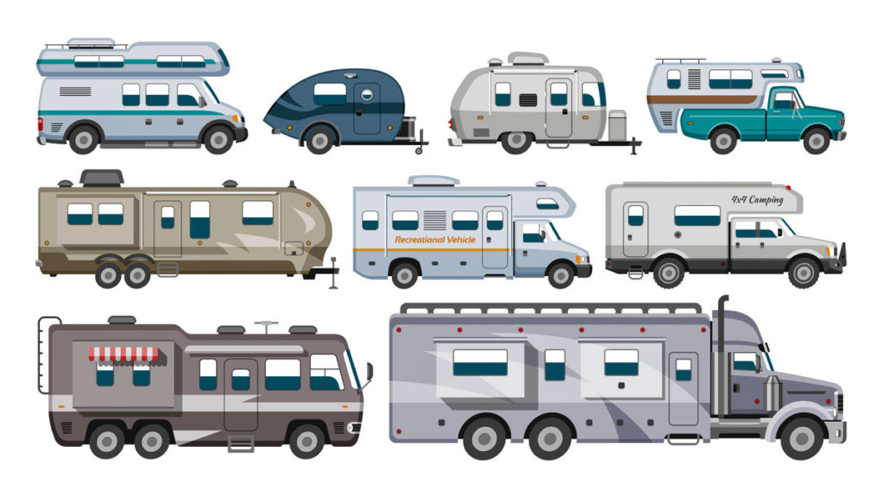Avoid crowds, planes, and hotels this summer with an RV rental; here’s everything you need to know.

Looking for a summer vacation free of airports and hotels? Up your road-trip game and rent an RV. Here’s what you need to know and think about before you rent your first RV.
1. Determine where you’re going
Where you want to go dictates what provisions you’ll need and the type of RV you’ll want to rent. Towing a too-large RV on narrow roads or worrying about under/over clearance isn’t fun.
2. Choose your rig
There are two main types of RVs: drivable and towable.
A. Drivable RVs are often referred to as motorhomes, meaning you drive and sleep in the same area. There are three types: Class A, Class B, and Class C.
–Class A RVs, by far the most spacious and luxurious recreational vehicles, are great for families and larger groups, as some can accommodate up to 10 people. If you choose one of these motorhomes , you need to be comfortable driving bus-sized vehicles and dealing with their parking limitations. If you want the luxury of a Class A vehicle without the hassle of driving it, many are available for delivery on the peer-to-peer rental sites (below).
–Class B RVs, also known as camper vans, are probably what come to mind when you think of those #vanlife posts on Instagram. They aren’t quite as spacious as other options on this list, but they’re much easier to drive and park. From custom vans to vintage Volkswagens, these vehicles are a great option for solo travelers, couples, and travelers with pets.
–Class C RVs are a great choice for first-time RVers. They have more space than Class Bs but are easier to maneuver than Class As. Class Cs, typically built on a truck chassis or van frame, are comparable to driving a big truck that requires wide turns. Most come furnished with a bathroom, shower, and full kitchen.
Note: RVs weighing under 26,000 pounds (most are under this weight) don’t require a special driver’s license.
B. As the name describes, towable RVs are towed by an SUV or pickup truck, which means you’re not sleeping in the same place as you’re driving.
–Folding or popup trailers are small and lightweight, meaning you can tow them with most trucks, SUVs, and even some cars. They have canvas sides that pop out, giving you space for sleeping, cooking, or hanging out. Some include showers and toilets but most don’t, and are generally the right size for a couple or small family.
–Fifth wheels need to attach to a special hitch in a pickup truck bed. They are much heavier than the other types of travel trailers so can only be towed by a truck with a high tow capacity. These types of trailers often have spacious layouts and luxurious amenities similar to those of Class A motorhomes.
–Travel trailers are similar to fifth wheels but don’t require a special hitch, which means they can be towed by minivans, SUVs, or trucks. They also tend to be smaller than fifth wheels.
–Truck campers are great if you want a “roughing it” experience that isn’t as rough as a tent. The camper part sits in the pickup truck bed and on top of the cab so you don’t need a hitch. Most provide the ability to cook, dine, and sleep.
3. Where to rent
There are two main rental sources: peer-to-peer or rental companies.
A. Peer-to-peer
RVshare and Outdoorsy are the Airbnb equivalents of the RV world. RVShare operates only in the USA, while Outdoorsy offers rentals in USA, Canada, and Australia.
Each peer-to-peer rental site offers a wide array of towable and drivable RVs. Thinking of a coast-to-coast road trip or a week of camping in a state park? No problem.
To make finding your perfect RV easier, both sites let you search by specific features, such as pets allowed, AC, TVs, and delivery options. For added peace of mind, both also offer worry-free payment and fraud protection. Cancellation policies are generous: 100% refund (other than the service fee) until just five days out.
B. Rental companies
If you prefer to rent from a business versus a private owner, check out these:
Cruise America: With 121 locations across the U.S., this is one of the most popular companies. However, it only rents Class C RVs so options are limited.
El Monte RV: This company rents in 27 states, offering both round-trip and one-way rentals. Similar to Cruise America, options are more limited as it only rents Class A and Class C RVs.
There is also Blacksford in Las Vegas and Bozeman, Montana (two great jumping-off points for national parks). It offers an all-inclusive pricing model for its smaller-sized RVs, which are based on the Mercedes-Benz Sprinter. Easy to drive, they come with just about everything you need, including fuel, cooking supplies, bedding, Wi-Fi, and (in some) a power generator. Renters also get unlimited mileage, liability insurance, and a national parks pass to cover entry fees.
4. Campsites
Just like with RVs, there are varying levels of campsites, ranging from ones that just offer a place to park to luxury sites with lake views, resort-style pools, 18-hole golf courses, and more.
The average RV campsite ranges from $35–$50/night; the more luxurious, the higher the price. Sites can easily go for over $100 per night, especially right now while they are in high demand. Most sites offer weekly and monthly discounts. Note: Some campsites can book up months in advance.
When choosing a campsite, consider what’s important to you. Does it offer drinking water, dump stations, electrical hookups, cable, internet, restrooms, etc.?
When campgrounds offer a full RV hookup, that typically means hookups for water, electricity, and sewage. An electrical hookup is perhaps the most commonly offered at campgrounds—it’s as simple as plugging in your RV and typically drawing 30 to 50 amps of power. Next is a water hookup, which to be clear, is vastly different than the sewer hookup. The water hookup will provide running water throughout your camper—that means pouring from your sink, in the shower, and allowing your toilet to flush. If you intend to drink the water, you’ll need to verify it’s from a potable water source before consumption. A sewer hookup, on the other hand, allows you to dispose of waste, which is collected in a separate holding tank under your RV. Some campgrounds will provide a sewer hookup at each site, while others have a main dump station. There are additional hookup amenities you may find at RV resorts or higher-end campsites, such as cable TV. And you’ll want to check if the campsite has Wifi.
You also need to decide if you need a pull-through or back-in spot. Pull-through spots often come at a premium because they are easier to park in; as the name implies, you pull into the spot and then continue driving forward to exit instead of having to back your RV into the spot. If you’re doing the latter, I recommend using cell phones on speaker to communicate with someone guiding you from outside the RV. Trust me.
Don’t forget to check out Harvest Hosts, HipCamp, and Boondockers Welcome, membership-based networks that provide access to free RV stays at places like wineries, breweries, farms, museums, as well as more ordinary sites in the U.S. and Canada.
If you’re looking to save money on campsites, consider boondocking for a night or two. What’s boondocking? Either the campsite you’re staying at doesn’t offer hookups—meaning you can’t connect to water, electricity, or sewer—or you’re backcountry camping or just staying in a parking lot overnight.
Note: just because a campsite doesn’t offer hookups doesn’t mean you can’t or won’t have water or electricity. Before boondocking, you can fill your RV’s fresh water tank to have access to water and, if the RV has a propane tank, you can use it for electricity. Just know neither of these will last forever; most freshwater tanks hold 20–100 gallons of water and a 30-pound propane tank usually offers 24 hours of generator use.
5. Cost
Like hotels, RV prices will greatly vary depending on what time of year you’re traveling, the cost of living in the city you’re renting from, how many people the RV accommodates, and how updated/luxurious the RV is. Here are average per-night costs for various RV types; of course, with high demand can come even higher prices.
- Class A: $175 to $500+
- Class B: $100 to $200
- Class C: $150 to $200
- Travel trailer: $50 to $125
- Fifth wheel: $60 to $150
- Pop-up trailer: $50 to $100
You may also need to factor in a per-mile charge. (You may be allocated a certain number of miles, after which you incur a fee per mile driven over the allocation; some rentals do come with unlimited miles.)
What about gasoline costs? Know you will probably burn through a boatload of it if you drive much. Headwinds, hot weather (you have to run the generator to have AC), and high speed limits are not your friend.
6. Insurance
You can buy coverage from the rental companies (much as you can from car rental agencies). The peer-to-peer sites offer some protection, too.
RV Share includes standard insurance in its fees but you can opt to add on additional coverage. Its website states standard coverage includes up to $200,000 in comprehensive and collision coverage based on the value of the RV and free 24/7 roadside assistance and free towing and tire service. You can read more on its policy here.
Outdoorsy partners with Liberty Mutual insurance and offers three levels: Peace of Mind, Essential, and Risk Taker. (I love the truth-in-advertising!) At a minimum, you get up to $1M physical damage protection, 24/7 roadside assistance, and customer support.
7. Helpful RV Apps
FreeRoam: This app provides information on free RV camp locations and overnight parking. It also posts reviews of for-pay RV campgrounds; including information on crowding, cell reception, safety, and ease of access.
Gasbuddy: This app shows the lowest gas prices in your area. You can even search based on brand and type of gas. Its trip-planning cost calculator comes in handy for budgeting.
RV Checklist: This app helps with pre-road trip preparation and packing. It offers checklists that are great for first-time RVers.
Free Zone Wi-Fi: This app provides information on 5 million hotspots in the U.S., maps to guide you to them, and automatic notifications when you’re in range of a signal.
Coverage?: Not all roads are created equal when it comes to cell service. This app provides a complete cellular coverage map for popular carriers across the United States.
8. Miscellaneous suggestions
Be sure you know how to set up your RV at a campground before you hit the road. Do a walk-through, read the manual, watch a video, and/or ask the owner or rental agent questions.
Driving an RV is more tiring than driving a car and you go slower, which means you’ll cover less ground per hour. Adjust your mileage expectations accordingly. You don’t want to spend all your vacay time behind the wheel instead of exploring! And you really don’t want to arrive at your campsite late and have to hook up your sewer and electrical after dark.
Be cautious when driving under anything with low clearance, including fast-food drive-throughs.
Twist’s Take: Avoid crowds, planes, and hotels this summer with an RV rental.

